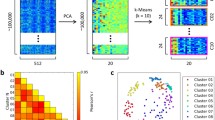Abstract
A new model is proposed that not only exhibits the major properties of primate spatial vision but also has a structure that can be implemented efficiently in a machine vision system. The model is based on a self-similar stack structure with a spatial resolution that varies with eccentricity. It correctly reproduces the visual cortical mapping function, yet it has the important attribute that it can produce invariant responses to local changes in the size and position of image features. By proposing a novel purpose for cortical “bar-detectors”, the model can also produce invariance to more general distortions. The structure of the model allows efficient hierarchical search to be made and it naturally embraces the concept of “attention area”. Exploitation of this model has already confirmed these properties and has also revealed its robust ability to control the focus and gain of machine vision systems.
Similar content being viewed by others
References
Barbur JL (1980) The spatial organisation of movementdetecting mechanisms in human vision. Thesis, University of London
Blakemore C, Campbell FW (1969) On the existence of neurones in the human visual system selectively sensitive to the orientation and size of retinal images. J Physiol (London) 203:237–260
Burt PJ (1981) Fast filter transforms for image processing. Comp Graphics Image Proc 16:20–51
Carlson CR (1978) Thresholds for perceived image sharpnes. Photogr Sci Eng 22:69–71
Cavanagh P (1982) Functional size invariance is not provided by the cortical magnification factor. Vision Res 22:1409–1412
Charman WN, Tucker J (1977) Dependence of accommodation response on the spatial frequency spectrum of the observed object. Vision Res 17:129–139
Crowley JL, Parker AC (1984) A representation for shape based on peaks and ridges in the difference of low-pass transform. IEEE Trans PAMI 6:156–170
Crozier WJ, Holway AH (1939) Theory and measurement of visual mechanisms. J Gen Physiol 22:341–364
Dow BM, Snyder AZ, Vautin RG, Bauer R (1981) Magnification factor and receptive field size in foveal striate cortex of the monkey. Exp Brain Res 44:213–228
Dyer CR (1984) A VLSI pyramid machine for hierarchical parallel image processing. IEEE Trans PAMI 6:381–386
Glazer F, Reynolds G, Anandan P (1983) Scene matching by hierarchical correlation. Proc IEEE CVPR, Washington DC, June 1983, pp 432–441
Graham N, Robson JG, Nachmias J (1978) Grating summation in fovea and periphery. Vision Res 18:815–825
Hirsch J, Hylton R (1982) Limits of spatial-frequency discrimination as evidence of neural interpolation. J Opt Soc Am 72:1367–1374
Hirsch J, Hylton R (1985) Spatial-frequency discrimination at low frequencies: evidence for position quantization by receptive fields. J Opt Soc Am (A) 2:128–135
Hubel DH, Wiesel TN (1962) Receptive fields, binocular interaction and functional architecture in the cat's visual cortex. J Physiol (London) 160:106–154
Johnson CA, Keltner JL, Balestrery F (1978) Effects of target size and eccentricity on visual detection and resolution. Vision Res 18:1217–1222
Koenderink JJ, Doorn AJ van (1978) Visual detection of spatial contrast; influence of location in the visual field, target extent and illumination level. Biol Cybern 30:157–167
Le Grand Y (1967) Form and space vision, Chap 8. Indiana University Press, Bloomington London
Limb JO, Rubinstein CB (1977) A model of threshold vision incorporating inhomogeneity of the visual field. Vision Res 17:571–584
Morgan MJ, Watt RJ (1982) Mechanisms of interpolation in human spatial vision. Nature (London) 299:553–555
Movshon JA, Thompson ID, Tolhurst DJ (1978) Spatial and temporal contrast sensitivity of neurones in areas 17 and 18 of the cat's visual cortex. J Physiol (London) 283:101–120
Pitts W, McCulloch WS (1947) How we know universals the perception of auditory and visual forms. Bull Math Biophys 9:127–147
Rovamo J (1983) Cortical magnification factor and contrast sensitivity to luminace-modulated chromatic gratings. Acta Physiol Scand 119:365–371
Sakitt B, Barlow HB (1982) A model for the economical encoding of the visual image in cerebral cortex. Biol Cybern 43:97–108
Schumer RA, Movshon JA (1984) Length summation in simple cells of cat striate cortex. Vision Res 24:565–571
Schwartz EL (1983) Cortical mapping and perceptual invariance: a reply to Cavanagh. Vision Res 23:831–835
Toates FM (1972) Accommodation function of the human eye. Physiol Rev 52:828–863
Watson AB (1983) Detection and recognition of simple spatial forms. In: Braddick OJ, Sleigh AC (eds) Physical and biological processing of images. Springer, Berlin Heidelberg New York, pp 100–114
Wilson HR, Bergen JR (1979) A four mechanism model for threshold spatial vision. Vision Res 19:19–32
Wilson HR, McFarlane DK, Phillips GC (1983) Spatial frequency tuning of orientation selective units estimated by oblique masking. Vision Res 23:873–882
Zeki SM (1978) Uniformity and diversity of structure and function in rhesus monkey prestriate visual cortex. J Physiol (London) 277:273–290
Author information
Authors and Affiliations
Rights and permissions
About this article
Cite this article
Burton, G.J., Haig, N.D. & Moorhead, I.R. A self-similar stack model for human and machine vision. Biol. Cybern. 53, 397–403 (1986). https://doi.org/10.1007/BF00318205
Received:
Issue Date:
DOI: https://doi.org/10.1007/BF00318205




